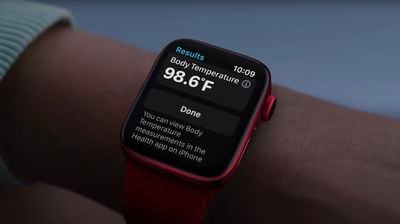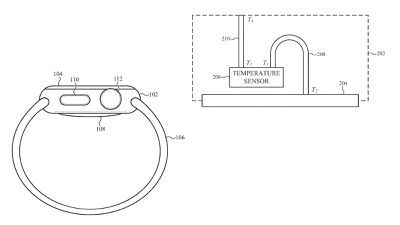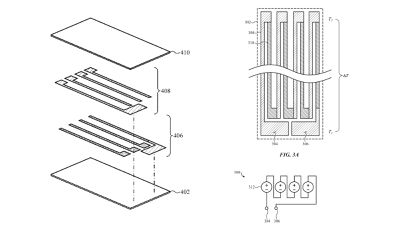Apple has been granted a patent for a temperature sensor suitable for the Apple Watch, just weeks before the company is expected to unveil the Apple Watch Series 8 with body temperature sensing capabilities.

The newly granted patent, spotted by MyHealthyApple, was filed with the United States Patent and Trademark Office and is titled "Temperature gradient sensing in electronic devices." While the wording of the patent suggests that it can apply to any device, the only device depicted in the patent's illustrations is clearly the Apple Watch, potentially hinting what specific application Apple has in mind for the technology.

Apple's patent protects an electronic device housing that encloses a temperature sensing system comprising a temperature sensor and a differential temperature probe. The system works by calculating the difference between two ends of a probe. One end touches the surface to be measured, while the other is connected to a temperature sensor. The difference in voltage across the different ends of the probe can then be correlated to a differential temperature measurement.
The temperature probe is configured to generate a voltage corresponding to a temperature gradient between a first end of the probe and a second end of the probe. The temperature sensor can be disposed within an electronic device housing. A first end of the probe can be coupled to the temperature sensor and a second end of the probe can be coupled to any suitable surface, whether internal or external, of the electronic device... In this construction, the temperature sensor can be configured to measure a temperature, at any given sampling time or sampling rate, of any surface or volume to which the sensing surface is exposed.
The patent goes on to explain in technical detail how the temperature sensing hardware works. Crucially, while the patent covers how a dedicated temperature sensor could be used inside a device to monitor the temperature of a component like the processor, it says that the sensor can be used to measure "absolute temperature" of an external surface, such as skin.
Most notably, Apple explicitly mentions how the location of the external probe may be located on a "back surface such as a back crystal of a smart watch" and says the system includes a "high-precision and high-accuracy absolute temperature sensor." The patent outlines several potential shapes and arrangements for the temperature sensor, with one of the more striking designs being a cross-shaped temperature probe.

According to Apple analyst Ming-Chi Kuo, Apple originally intended to offer a body temperature measurement feature with the Apple Watch Series 7 models, but the company shelved the plans when the body temperature algorithm it had developed failed to meet requirements before the device entered the engineering validation testing (EVT) phase last year.
The problems Apple has experienced relating to body temperature measurement purportedly relate to the fact that skin temperature quickly varies based on the environment, and since a smartwatch cannot monitor core body temperature using hardware, the feature is heavily dependent on an algorithm that produces accurate results. This patent only covers the hardware setup for a temperature sensing system, rather than the algorithm required to produce accurate results.
While Apple's patent filings cannot be taken as concrete evidence of the company's exact plans since many of its patents are never used, they do show its areas of research and development, and sometimes reveal impending products, such as the AirTag.
In this case, it is difficult to look past the plethora of reports about the Apple Watch Series 8 offering a body temperature sensor – something that has long been rumored by sources like Kuo. Reports indicate that while the device is unlikely to offer exact body temperature measurements, the sensor will be used to provide at least two new health monitoring features.
The Wall Street Journal and Bloomberg's Mark Gurman state that the body temperature sensor will aid fertility planning, giving women insights into their ovulation cycle. Apple has focused on women's health in recent years, so expanding features in this area seems to be in line with the company's objectives.
Moreover, the body temperature sensor could be used to improve the detection of patterns when tracking sleep. Apple leveraged blood oxygen sensing capabilities during sleep starting with the Apple Watch Series 6 and significantly bolstered the Apple Watch's sleep tracking in watchOS 9, meaning that further improvements in this area aided by hardware this year seem very plausible.
Apple is also said to have plans to enable the body temperature sensor to detect when a user has a fever, but it seems unlikely that this feature will be available upon the launch of the Apple Watch Series 8. Gurman believes that further in the future, Apple Watch models could determine if a user has a higher than normal body temperature, but it is still unlikely to show an exact measurement.























